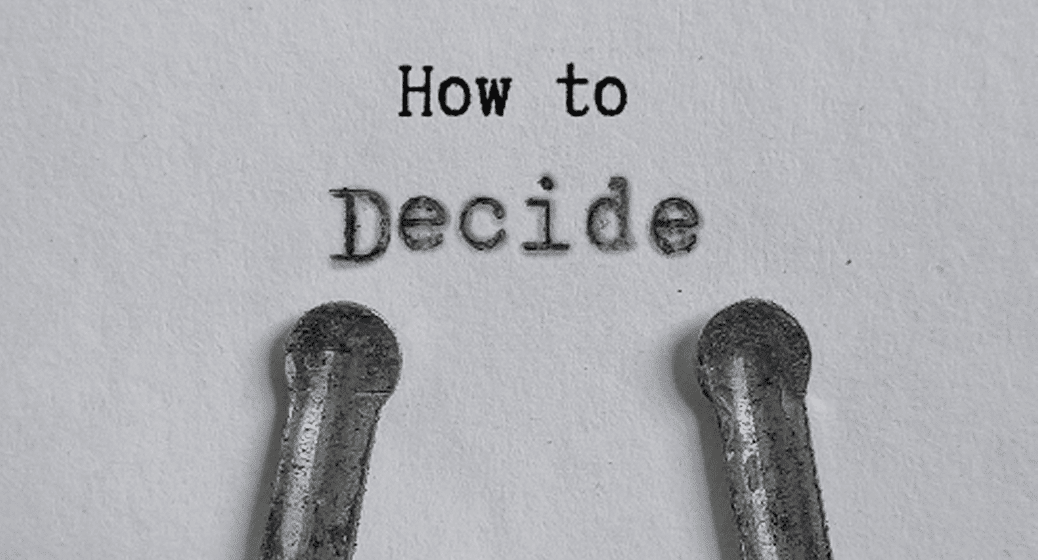Decision-Making Tip #1: Open Your Options
We often overlook many viable options in favor of only a couple that are easy to see when trying to make a decision. Even if they aren’t ones you want to pursue, allow yourself to consider all possible options before narrowing them down. Start by asking yourself, what are the options I haven’t considered or dismissed? Also, consult others for options you may not be able to see.
Decision-Making Tip #2: Find Your Feelings
One way to access your feelings is by using a coin flip exercise. Assign one decision to heads of a coin and the other to tails. Imagine a positive outcome for each decision. For instance, let’s say you’re trying to decide whether to stay or leave your partner. If your coin lands on heads, you’ll decide to stay and find you’re feeling very close to this person, full of trust and love; desire excitement. If it lands on tails, you find yourself on your own; your relationship is behind you, and you’re moving in a fresh new direction in your life, grateful for the past and excited about the future. You have fond feelings for your partner but in a very distant, detached way, like an old memory or time that has long since passed.
Before flipping the coin, notice if you feel a visceral pull towards heads or tails. Once you flip the coin, pay close attention to what happens in your body for the first five seconds after it lands; notice your muscles, your breath, etc. Do you relax or tense up, feel flush or chilled, light or heavy? These somatic signals can provide important information that may not be available to your conscious mind.
Decision-Making Tip #3: Cost-Benefit Scale
Take two pieces of paper, using one for each option you’re trying to decide between. Draw a line down the middle of each. On one side of the page, write all the advantages you can think of for making a decision (ie, Option #1) and all the disadvantages on the other side of the middle line. Do the same thing on the other page for Option #2. Now weigh the advantages against the disadvantages for each option using a 100-point scale. For example, for Option #1, you might give 60 points for the advantages and 40 points for the disadvantages, while maybe you give 30 points for the list of the advantages in Option #2 and 70 points for the disadvantages. When you evaluate the points assigned to each column, be sure to base them on the importance or value to you of the items on the list, not just the number of items. This will help you get things out of your brain and onto paper, and the score differential will provide perspective on how you are valuing each option. Don’t rush through the exercise; take a few days to fill in your columns, adding to your lists each day as you come up with new advantages and disadvantages. It can also be helpful sometimes to consult with friends and family as you do this process, as they may think of things you hadn’t considered.
Decision-Making Tip #4: Know Your Fear
When we’re struggling to make a decision, it’s because we’re afraid of a certain outcome. It can be helpful to understand what indecision is protecting you from by uncovering your fears. If you’ve already done the Cost-Benefit Analysis (Tip #3 ), review what you put in your columns and circle the ones you find are based on fear. Another way to uncover your fear is to play out the worst-case scenario for each option. This will expose what is it you’re afraid of and why. Once you’ve identified your fears, step back and assess their probability fears and brainstorm ways you could cope if they came to pass. This moves you out of avoidance and into a more realistic assessment of your options.
Decision-Making Tip #5: Like Your Reasons
Make sure you understand why this decision is important to you and like the reasons you determine. How does your intention behind wanting to make this decision reflect your values, standards, goals, etc.? Take the time you need to clarify your reasons and how they align with who you want to be in the world.
Decision-Making Tip #6: Good Story Stacking
When it comes to making a decision, sometimes our brain can back us into a corner by giving us only bad options to choose from. Or, more specifically, we give ourselves bad stories about the options we see. When you create a negative story around your options, it’s very hard to make a decision. In this exercise, challenge yourself to create a story for each option in a way that each leads to a positive outcome. If you make all your options result in negative outcomes, you’ll be resistant to making any decision. It’s important to give your brain a way forward where you can be happy no matter what you decide. The other reason it’s important to stack a good story for each option is that you want your decision to be fueled by a positive emotion. More often than not, we unconsciously make decisions from a negative emotion in the hope it will lead to a positive outcome, but this is rarely the case.
Decision-Making Tip #7: Ask Your Future Self
Imagine yourself sometime in the future when you are wiser, more knowledgeable, and more understanding of your current situation. Imagine this future self having resolved whatever dilemma you’re facing now and living your life in a way that reflects your current hopes, dreams, goals, etc. Now have a dialogue with this future you. It’s most effective to write this out as you would a screenplay with your current and future selves playing two separate roles. Ask your future self for their thoughts, opinions, ideas, or reflections on the decision you’re considering from their unique future vantage point. This simple exercise can be a powerful portal to your higher wisdom that otherwise can be difficult to access.
Here are some final key concepts to keep in mind when making a decision:
- A decision is a commitment to a thought, feeling, and actions that create an outcome.
- There are no inherently right or wrong decisions, only ones that are right and wrong for you.
- How you feel about a decision is not based on whether it’s a good or bad decision, it’s about how you think about your decision.
- The only thing that makes one decision better than another is just the way you think about it, so it’s worth doing the work to think deliberately in a way that you support yourself and the choices you make.
- Don’t make decisions to change how you feel; change how you feel and then make the decision.
Keep Reading
Want more? Here are some other blog posts you might be interested in.








